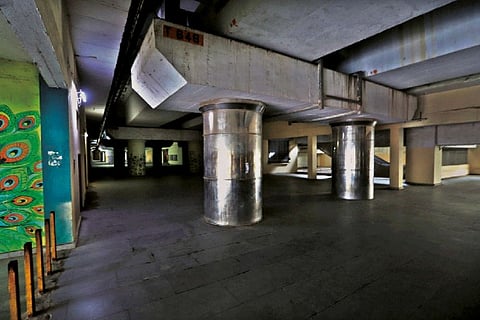

Chennai
The Mass Rapid Transport System, popularly known as MRTS, has never been in the news for good. The transport mode, connecting the core city with the IT corridor, was rebuked for its poor maintenance of the stations and deserted corridors and the patronage shows there is a lot that needs to be done to make the elevated transport an acceptable model. To begin with, the stations need CCTV surveillance forthwith.
In December last, the MRTS was in the news for the brutal attack on an RPF constable in Perungudi followed by the robbery of a passenger by a gang in Taramani. Vehicle thefts and rape attempts continue to be reported from different MRTS stations, but nothing seems to have been done to address the security issues as is confirmed with the latest case — retrieving skeleton of an unidentified man from Greenways Road. What is more worrying is that the body was left to decay on the station premises for months together as a few youth, detained for inquiry on suspicion, informed the investigating officers that they noticed the body in a decomposed state in November last year itself.
Inquiries with police revealed that the MRTS stations were den for anti-socials during the lockdown as the entire railway police (GRP) and RPF were moved to the Central station to coordinate the special trains for guest workers, leaving the already deserted station premises with little or no surveillance. Though the train services resumed, the stations are taken over by the miscreants after around 10 pm.
Deserted basements
One of the major reasons for this, as a police officer pointed out, was the unused spots in the station complexes. “Of the 18 stations, all the complexes housing elevated line have a basement area below the ground level and most of them remain unused. During monsoon it gets waterlogged and the rest of the year, it is one huge dark space even during the day. Even if one shouts from there, it won’t be heard outside. There is no light, so nobody knows even if 100 people are hiding there. Though the railway authorities have closed the entry and exit points in many stations, the sealing withered over the years paving way for miscreants to misuse the areas for illicit activities. These are the areas where youngsters addicted to ganja frequent,” said a police officer. The youth who spilt the beans on the skeleton also told police that they noticed it when they went in with ganja. Joint Commissioner (East) V Balakrishnan said the city police submitted a report to the authorities concerned to close these basements permanently years ago.
Subway below tracks
Another area of the MRTS stations where the anti-socials find refuge is the passages below the railway tracks between the stations. “This passage, four feet in height connects all the elevated stations and one can walk through the stretch bending the body. A few years ago, when we tried to secure a few crime accused, they managed to get into the passage by climbing the pillars in Triplicane and escaped via the next opening,” said the officer on condition of anonymity. Abiramapuram police suspect the unidentified person could have been murdered in the nearby stations and the body brought to Abiramapuram MRTS through this passage, as there is no sign of blood stains or any other signs of murder near the area where the skeleton was found.
Abandoned rooms
Similarly, a railway police official told DT Next that there are rooms in stations such as Taramani and Perungudi, which are misused by miscreants who bring women and transpersons at odd hours for sexual activities. When asked why the station premises could not be provided with better surveillance, the officer said, “We need at least two personnel to guard both ends of each station per shift, which means six personnel per station. There are 18 stations and the total number of personnel required is 108. But the strength available is too little to guard all the stations round the clock. If we are provided with the required strength, we would be able to function well.
Surveillance being improved
When contacted, a senior railway official said steps are being taken to make MRTS stations safer and passenger-friendly. “We have already issued an order to the entry points to basements at MRTS stations. Apart from the 125 RPF staff, the Railways recruited 23 ex-servicemen recently to augment the security of MRTS. Also, 40 CCTV cameras were installed at Tirumailai and 16 cameras at Chennai Beach. Sanctions have been issued to bring the remaining stations too under CCTV surveillance. Night patrol is being done by one sub-inspector and four armed staff,” said the official. However, there was no response to a query if the MRTS would be taken over by the Chennai Metro Rail Ltd.
Visit news.dtnext.in to explore our interactive epaper!
Download the DT Next app for more exciting features!
Click here for iOS
Click here for Android